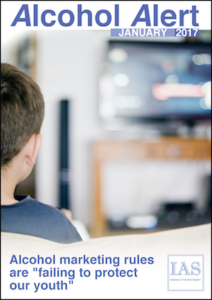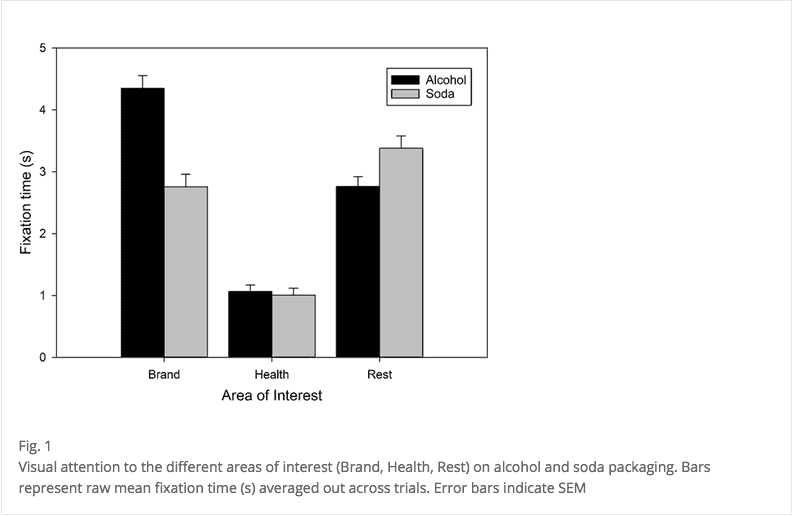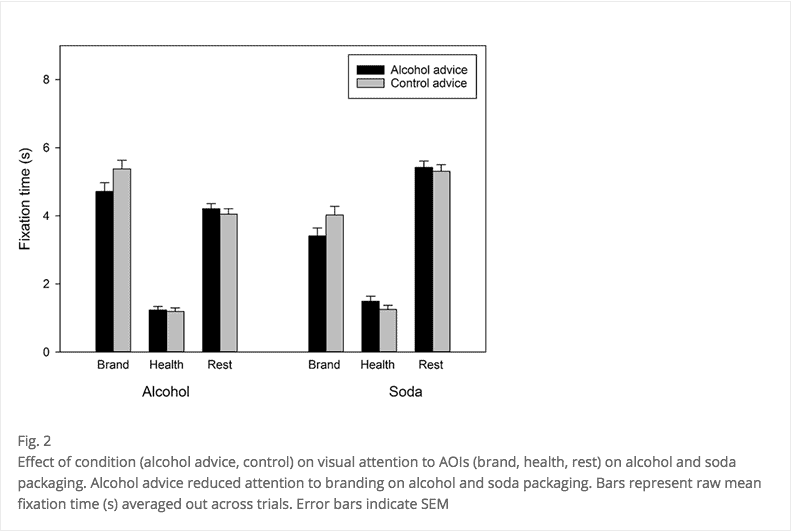In this month’s alert
Editorial – January 2017
Welcome to the January 2017 edition of Alcohol Alert, the Institute of Alcohol Studies newsletter, covering the latest updates on UK alcohol policy matters.
In this month’s issue, Alcohol marketing rules are “failing to protect our youth”, according to the supplement of a special edition of the Addiction journal. Other articles include: Community Alcohol Partnerships found to be largely ineffective; the number of drink drivers caught by Scottish Police during the Christmas period rose on the previous year; and international research shows UK foetal alcohol rates are among the highest in the world.
Please click on the article titles to read them. We hope you enjoy this edition.
TOP STORY: Alcohol marketing rules failing to protect our youth
Greater exposure raises likelihood of earlier and heavier drinking (10 January)
Young people across the world are over-exposed to extensive alcohol marketing practices, claim leading public health experts, who want governments to renew their efforts to address the problem by strengthening the rules governing alcohol marketing with more effective independent statutory regulations.
Their call coincides with the publication of a series of reports in a special edition of the scientific journal Addiction that presents the latest evidence on alcohol marketing and its impact on children. Key findings from the collection of peer-reviewed manuscripts include:
- Exposure to alcohol marketing is associated with youth alcohol consumption
- Analysis of alcohol promotion during the 2014 FIFA World Cup indicates alcohol marketing practices frequently appeared to breach industry voluntary codes of practice’
- Alcohol industry self-regulatory codes do not sufficiently protect children and adolescents from exposure to alcohol promotions, especially through social media.
The Addiction supplement comprises 14 papers, with research presented from around the world.
Alcohol is the leading cause of death and disability for young males aged 15–24 in nearly every region of the world, and young females of the same age in the wealthy countries and the Americas.
The new systematic review – which identified 12 additional studies – found an association between level of marketing exposure and youth drinking behaviour, and found that exposure to ads was even more strongly associated with progression to binge drinking than with initiation of alcohol use.
“This latest review of the scientific literature adds stronger evidence to the claim that exposure to alcohol marketing among youth is linked to more underage youth drinking and, in particular, binge drinking,” said study leader David Jernigan, PhD, the director of CAMY and an associate professor in the Department of Health, Behavior and Society at the Bloomberg School.
The supplement’s lead editor, Professor Thomas Babor of the University of Connecticut said: “Governments are responsible for the health of their citizens. No other legal product with such potential for harm is as widely promoted and advertised in the world as alcohol. These papers provide a wealth of information to support governments in their efforts to protect children and other vulnerable populations from exposure to alcohol marketing.”
Methods
The researchers relied upon four different medical and scientific databases to identify articles for possible inclusion in the review. Studies were included in the final review if they met a number of criteria, including whether they used original data and included measures of marketing exposure and alcohol consumption for at least 500 underage youth. Studies were included only if they used self-reported and observed actual alcohol use such as binge drinking, as opposed to just measures of intentions to consume alcohol in the future. The studies were conducted in seven countries and involved more than 35,000 participants.
Several of the included studies found that levels of marketing exposure appear to be as high or nearly as high among younger adolescents as they are among older adolescents and young adults, suggesting that current voluntary alcohol industry marketing codes are not protecting kids as young as 10 years old.
Reaction
Alcohol NGOs and health experts welcomed the findings as further evidence of self-regulation’s failure to curb alcohol marketing to young people. Chris Brookes of the UK Health Forum noted that: “Governments have previously approved self-regulatory measures on alcohol advertising; however, we can no longer say that they might work to protect our young people – they don’t. In a literature review of more than 100 studies, none was identified that supported the effectiveness of industry self-regulation programmes.”
However, the advertising industry regulator has criticised the research, claiming that the UK’s regulatory framework has had a positive impact on recent official figures showing under-age drinking at a record low and a decline in binge drinking.
“Alcohol policy is clearly on the right track and alcohol advertising – which protects children and respects adults – is an important part of that,” says Ian Barber, the AA’s director of communications.
In the UK, advertising for alcoholic drinks follows a code enforced by the Advertising Standards Authority, while the packaging and branding of the products is subject to self-regulation. And according to the Guardian, AB Inbev and Diageo, two of the world’s biggest alcoholic drinks makers, have reported ploughing as much of 15% of their annual global sales back into marketing, amounting to £5.75bn and £1.6bn respectively.
Ian Hamilton, lecturer in the Department of Health Sciences at the University of York, whose interests include substance use addiction, told the newspaper the AA’s claim that the UK’s alcohol advertising rules are among the strictest in the world, major operators had nevertheless found ways to evade marketing legislation the UK.
“Some of the messages are quite subtle, but they are persistent,” he said. “So this idea that alcohol is necessary for social success, or is both a stimulant as well as a sedative, that it removes sexual inhibition, that it improves – bizarrely – your sporting and mental abilities.
“Of course, the way they do it is they don’t say go and buy Carlsberg, but they’ll do endorsed interviews with celebrities or they’ll offer free music downloads or notices of events, so they do it in quite subtle and clever ways.”
Solutions
The papers offer guidelines to developing more effective alcohol marketing regulations:
- The most effective response to alcohol marketing is likely to be a comprehensive ban on alcohol advertising, promotion and sponsorship, in accordance with each country’s constitution or constitutional principles
- Regulations should be statutory, and enforced by an appropriate public health agency of the local or national government, not by the alcohol industry
- Regulations should be independent of the alcohol industry, whose primary interest lies in growing its markets and maximising profits
- A global agreement on the marketing of alcoholic beverages would support country efforts to move towards a comprehensive ban on alcohol advertising, promotion and sponsorship
- Collaboration with other population-level efforts to restrict marketing of potentially harmful products, such as ultra-processed food, sugary beverages, tobacco, and breast-milk substitutes, should be encouraged and supported.
“It is clear that self-regulation is not working and we welcome calls for greater action from governments to protect children from exposure to alcohol marketing,” said Prof Sir Ian Gilmore, chair of the Alcohol Health Alliance (AHA), an umbrella group of more than 40 UK health NGOs, including the Academy of Medical Royal Colleges.
Hamilton also warned that a blanket ban on alcohol advertising could be seen as “taking a sledgehammer to crack a nut”, with the danger that such a policy could give drinking a kind of outlaw prestige that might increase its appeal to some. But he admitted that a similar policy on tobacco advertising had apparently proved successful in diminishing the appeal of smoking. “I think the state does have some kind of responsibility,” Hamilton said. “We can’t have do-it-yourself regulation by industry whose prime motive is to find the next generation of consumers.”
The Addiction supplement, ‘Alcohol marketing regulation: From research to public policy’, is freely accessible from the Wiley Online Library. You can also listen to David Jernigan talk about the supplement’s findings in greater depth in our Alcohol Alert podcast.
Community Alcohol Partnerships “likely to be ineffective”
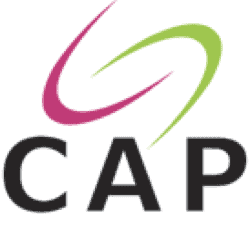 “No convincing evidence” that industry-led initiatives work, say researchers (09 January)
“No convincing evidence” that industry-led initiatives work, say researchers (09 January)
Community Alcohol Partnerships (CAPs) are “likely to be ineffective” at reducing alcohol-related harms. This is the finding of the PIRU research team at the London School of Hygiene & Tropical Medicine.
Published in the Journal of Public Health, their study found that just three out of the 88 CAP initiatives evaluated used controlled designs or comparison areas. The most robust evaluations found little change in anti-social behaviours (ASB), though few data were presented. Overall, CAPs appeared to affect public perceptions of anti-social behaviours, although this bore no reflection on their true efficacy.
The research team “searched CAP websites and documents, and databases, and contacted CAPs to identify evaluations and summarise their findings”, appraising them against four methodological criteria: (i) reporting of pre–post data; (ii) use of comparison area(s); (iii) length of follow-up; and (iv) baseline comparability of comparison and intervention areas.
They found that despite industry claims about the success of CAPs, there were few evaluations, and no convincing evidence that CAPs are effective in reducing alcohol harms or anti-social behaviour. In addition to this, most CAPs focused on educational interventions which wider research evidence consistently shows are likely to be ineffective.
CAP activities mainly focus on reducing visible anti-social behaviour by seeking to reduce access to alcohol at source (through enforcement, and by training and advising retailers). These activities are consistent with the Responsibility Deal pledge A7(a), which aims to support local partnership working. Seven CAPs are cited in Responsibility Deal (RD) progress reports as evidence of CAP effectiveness, although only one (the Kent CAP cited by Shepherd Neame Ltd) involved a control group, and this evaluation does not provide strong evidence that any change – other than a change in public perceptions – was due to the CAP.
The study stated that public perceptions are “not a robust independent measure of the effectiveness of CAPs as it is likely that CAPs set out to selectively encourage positive media coverage.”
“Their main role may be as an alcohol industry corporate social responsibility measure which is intended to limit the reputational damage associated with alcohol-related ASB”, the report concluded.
Alcohol marketing in Africa violates industry’s own marketing codes
Results from a study spanning seven countries (10 January)
More than a quarter of all monitored alcohol advertisements violated the industry’s own marketing codes, according to a study covering seven African countries.
The MAMPA project, Monitoring Alcohol Marketing Practices in Africa, which documents alcohol marketing practices across Ghana, Nigeria, Uganda, The Gambia, Kenya, Malawi and Namibia, published its third report, “Evaluating compliance with alcohol industry self-regulation in seven countries in Africa”. Commissioned by FORUT, an independent analysis comparing alcohol advertising practices in Africa with the industry’s own advertising guidelines produced the following messages:
- Alcohol promotion directed at young people is associated with earlier onset of drinking and an increased risk of problem drinking;
- More than a quarter (27.7%) of the studied advertisements were found to contain at least one violation of the alcohol industry’s own marketing codes;
- The most common violation was related to the guideline which refers to “the effect of alcohol”, because of the suggestion that alcoholic beverages can enhance attractiveness and/or remove social or sexual inhibitions;
- Industry self-regulation systems do not work. The findings point to the need for systematic surveillance of alcoholic beverage marketing to protect vulnerable populations, such as young people who may already be experiencing problems related to their alcohol use.
The report underscores the need for policy strategies to more effectively monitor and regulate alcohol advertising across all media outlets, as well as the option of complete bans in certain areas of alcohol advertising where necessary.
Number of festive drink drivers in Scotland up
Strong enforcement campaign catches more offenders (10 January)
Scotland’s roads saw the highest number of drink drivers caught over the Christmas period since the limit was lowered in December 2014.
The proportion of drivers stopped by police who were found to be over the limit rose on the same time last year. Of the almost 19,000 drivers stopped during the 2016/17 festive period campaign, a total of 625 – or 1 in 30 – were over the limit, compared with 1 in 36 – during the same period in 2015/16. Of the 625 detected, 46 were caught in the morning having been drinking the night before, up from 13 in 2015/16.
Police Scotland’s four-week enforcement campaign saw an average of 610 drivers tested every day, a 15% rise in the number of checks carried out the year before. It also coincided with a Scottish Government awareness campaign to reinforce the message that ‘the best approach is none’.
First Minister Nicola Sturgeon’s responded to the figures by noting that the vast majority of those caught were over not only the new lower alcohol limit but the previous higher limit. More than 9% of those caught drink driving tested between the old and new limits, up on 4% the previous year.
She said: “It is more than disappointing to see a rise in the number of drivers who flouted the law and put at risk their lives and the lives of others over the festive period. There is only one safe level of alcohol if a person is driving: none at all.”
Assistant Chief Constable Bernard Higgins said, “It is an absolute disgrace that so many people were prepared to risk their own lives, as well as the lives of innocent people, by recklessly taking to the roads while in a drunken state.
“We were massively active over the festive season and while the number of tests we carried out was greater than last year, proportionately the number of people caught, particularly those the following morning, was greater still.
“Drivers need to take far greater personal responsibility, and also be aware that while this campaign is over, my officers still have a very sharp focus on detecting and arresting drunk drivers. I repeat the guidance given at the start of the campaign – don’t risk it, because – as these 625 people have found to their cost – we will detect and arrest you.”
Treatment for alcohol misuse among young people falls
 Scale of problem still substantial; nearly half of patients seek help for alcohol (12 January)
Scale of problem still substantial; nearly half of patients seek help for alcohol (12 January)
The number of young people seeking treatment for alcohol misuse continues to fall, according to the latest figures published by Public Health England (PHE).
The 2015–16 annual report on young people’s use of specialist substance misuse treatment services – part of the National Drug Treatment Monitoring System (NDTMS) – shows that the numbers of young people seeking treatment for problems with drugs and alcohol (17,000) continues to decline, since a peak in the numbers in 2008–09 (24,000).
“While this is encouraging, and is in line with what we know about the declining use of drugs and alcohol among young people, we need to look behind the headline to understand the full picture,” wrote Rosanna O’Connor, director of the Alcohol, Drugs & Tobacco division within PHE’s Health and Wellbeing Directorate in the Public Health Matters blog.
“Young people do not develop substance misuse problems in isolation. The 2015–16 data shows that a significant proportion of young people who entered specialist treatment services also had other multiple problems or vulnerabilities that were linked to their substance misuse.” These include having a mental health problem, being affected by domestic violence or sexual exploitation, or not being in education, training or employment.
Cannabis and alcohol continue to be the main substances for which young people are most likely to seek help, alcohol being the second most cited substance (48%). However, numbers in treatment for alcohol misuse have been declining steadily in recent years, and this figure is much lower compared to the 67% reported in 2009-10. The proportion of young people citing alcohol as a primary substance fell to 2,556 young people (15% of the total in treatment) seeking help during 2015–16 from 3,133 (17%) the previous year, and is significantly lower than the 2008-09 peak of 8,799 (37%). It is now at its lowest ever level since records began.
“It is encouraging that the numbers of young people being treated for substance misuse is going down”, said Rosanna. “However it is important to emphasise the complex vulnerabilities experienced by this group and the need to ensure that treatment services are effectively joined up with other young people’s health and social care services.”
This is provided by the rapid mixed methods evidence review, commissioned by PHE and undertaken by The Children’s Society, is a review of young people’s specialist substance misuse services, produced in order to help commissioners improve those services.
“The review provides important advice and we encourage commissioners of young people’s treatment services to read in conjunction with the 2015–16 annual report”, Rosanna added.
Portsmouth City Council fails in bid to ban strong ciders
Industry watchdog sides with producers in dispute over drinks’ packaging (12 January)
A city council has failed in its bid to ban independent convenience stores and off-licences from selling a leading strong cider brand.
Portsmouth City Council complained to the Portman Group drinks industry watchdog about the 8.4% ABV K Cider brand, sold in 500ml cans. The council stated that the packaging promoted immoderate drinking and urged the consumer to drink rapidly or ‘down’ the product in one. Local authority officials believed that the combination of the strength of the product plus the fact it was served in a non-resealable can, encouraged consumers to drink immoderately (a K Cider can contains 4.2 units of alcohol).
Portsmouth City Council filed a similar complaint for Oranjeboom, while a third identical complaint was made by Medway Council about the packaging of Crest Super (which contains 5 units per can).
In response, brand owner C&C Group claimed the consumption of 4.2 units of alcohol in one sitting could not be seen as either immoderate or irresponsible, referring to the old out-of-date government’s drinking guidelines which state that men “should not regularly exceed three to four units in one day”. Today, daily recommended amounts no longer exist; new guidelines state that for regular drinkers, “You are safest not to drink regularly more than 14 units per week” and that if one does reach 14 units, “it is best to spread this evenly over 3 days or more”.
The Portman Group’s Independent Complaints Panel sided with the producers, remarking that they could not see anything on the packaging that would encourage a consumer to drink rapidly or to ‘down’ K Cider in one go, although it considered the evidence was “weak” that the brand was a premium product sold at a premium price.
The Panel said they could not infer from the evidence presented that 4.2 units for K Cider and 5 units for Crest Super of alcohol on one occasion were immoderate levels of drinking, and therefore they concluded there was insufficient evidence to find a breach of Code.
For Oranjeboom, the Panel discussed the prominence of the 8.5% level of alcohol, and the words ‘imported’ and ‘extra strong’. They concluded that as the product was available in different strengths it was useful for the consumer to know that the product was 8.5% abv, while the words ‘imported’ and ‘extra strong’ were factual and not unduly emphasised. Again it found this product not to be in breach of the Code.
Secretary to the Independent Complaints Panel, Kay Perry, said: “Alcohol producers must be mindful not to encourage immoderate or irresponsible drinking when designing the packaging of their products.”
K Cider is the fifth-biggest cider brand in the convenience channel, with sales of £15.3m in the year to April 2016, according to Nielsen data. Year-on-year sales grew by 23.5%, making it the fastest-growing top 10 cider brand.
Women’s drinking habits misrepresented in the media
Female binge drinking portrayed more negatively than male binge drinking (13 January)
Research released in recent months has brought new insight into women’s alcohol consumption and its representation in the media. Findings from a 2016 analysis of 68 international studies show that the gender gap between women and men’s alcohol consumption and related harms has now closed. Whilst men in generations born in the early 1900s were more than twice as likely as women to drink alcohol and more than three times more likely to experience alcohol-related harm, for those born in the late 1990s, these gaps have shrunk dramatically. Men born in this period are now only 1.1 times more likely to drink alcohol than women and only 1.3 times more likely to experience alcohol-related harms.
Concurrently, analysis has revealed the nature of women’s drinking is misrepresented in the media. Exploring 308 articles from eight leading UK news outlets, researchers from the University of Glasgow and Glasgow Caledonian University found female binge drinking to be portrayed more negatively than male binge drinking. As well as this, women’s binge drinking was typically framed in moralistic terms, with articles likely to focus on appearance, and to characterise female binge drinkers as socially transgressive and a burden on fellow male drinkers.
Such coverage was typified by a Daily Mail article titled “Pictures that make me weep for today’s young women: SARAH VINE on how British society is in the grip of an out of control binge-drinking culture”, in which women are descried as wearing an “indecently short dress” and as “semi-naked”, while female binge drinking is discussed. The article’s moralistic approach has been questioned by others in response.
The importance of such misrepresentations of women’s drinking has been highlighted by new figures that show the percentage of female drink-driving convictions has nearly doubled since 1998 to 2012.

Speaking with SAGA in response to this statistic, Katherine Brown, director of the Institute of Alcohol Studies, notes: “Our perception of which women are heavy drinkers are those we can see doing it – essentially, young girls out partying on a Saturday night. But the research shows middle-class, middle-aged women are the ones who are drinking the most.
“And whilst many of them may be completely responsible when it comes to booking a taxi after drinking at a party or a wedding, they might not see the more everyday issues – such splitting a bottle of wine at a book group, or having a glass of wine over dinner and then nipping out to pick up a child from drama club, as a problem.”
Echoing these comments, the research team at the University of Glasgow and Glasgow Caledonian University note that inaccurate media representations, characterising female binge drinking as a preserve of the young, may obscure understanding for the wider population of what binge drinking is and the harms associated; by focusing on specific groups or settings for drinking, it may lead those who fall outside these to misinterpret their own drinking habits and the risks associated.
Scotland: Report calls for total ban on cut-price alcohol
“No more discounted booze” say campaigners (16 January)
Alcohol campaigners have called on the Scottish Government to ban all special offers on booze in shops and supermarkets.
Recent figures in new report Changing Scotland’s Relationship with Alcohol show that 31.2 of 100,000 male deaths in Scotland in 2014 were due to alcohol, compared with 18.1 in England and 19.9 in Wales.
Recommendations to ministers to tackle the problem include:
- Stopping shops and supermarkets from offering cut-price alcohol deals
- Prohibiting alcohol advertising and advertising in public spaces
- Phasing out alcohol sponsorship of sports events, music and cultural events
- Restrict alcohol advertising content to factual information, such as composition, origin and means of production.
Alcohol Focus Scotland chief executive Alison Douglas said: “To reduce the immense harm caused to people’s health, their families and our communities, we need to increase the price of the cheapest alcohol.
“Shops and supermarkets constantly promote alcohol on the basis of price alone but alcohol isn’t like other groceries. It is an age-restricted, addictive product that causes a great deal of harm, so promoting ‘great prices’ and ‘special offers’ should be prohibited because it manipulates consumers into buying more.”
Ewan Macdonald-Russell, head of policy at the Scottish Retail Consortium (SRC) said: “Scotland already has a restrictive and complicated licensing regime which restricts the manner and approach retailers can take to promoting alcohol products.
“These proposals are unlikely to have a significant effect on the problems of alcohol abuse but will definitely hit ordinary Scots who are just looking for a good deal on their weekly bottle of wine.”
But public health minister Aileen Campbell hinted that there was scope for a further tightening of Scottish alcohol policy. She said: “Scotland has a difficult relationship with alcohol, with the most harm being caused by cheap, high-strength alcohol. We remain committed to minimum unit pricing. We have already banned multi-buy discounts and will consider what further action to take.”
UK foetal alcohol rates among highest in the world
Two-in-five pregnant women admit to drinking during pregnancy (19 January)
A new study by the Canadian Centre for Addiction and Mental Health (CAMH), published in the Lancet Global Health, has shown that more than 40% of pregnant women in the UK drink while pregnant, placing the UK among the five countries in the world with the most prevalent alcohol use during pregnancy (alongside Russia, Ireland, Denmark, and Belarus).
The research also found that Britain has one of the highest rates of Foetal Alcohol Syndrome (FASD) in the world, with an estimated 61.3 cases per 10,000 births – significantly higher than the global average of 15 per 10,000, ranking the 44th worst in Europe.
Foetal alcohol syndrome can leave babies with learning difficulties, behavioural problems, hearing and vision loss, poor growth and organ damage. The problem is growing too; worldwide, an estimated 119,000 children are born with FASD, and although the exact prevalence of UK cases is not known, one newspaper reported a 37% jump in the number of cases in England between 2010 and 2013.
Experts claim that it is a common misconception that drinking in pregnancy was only associated with social deprivation and warned that professional women are increasingly drinking heavily in their first trimester, often unaware that they were expecting.
“The safest thing to do is to completely abstain from alcohol during the entire pregnancy,” urged Dr Svetlana Popova, lead author of the study and senior scientist in CAMH’s Institute for Mental Health Policy Research.
These sentiments echo the low risk drinking guidelines laid down by the UK’s Chief Medical Officers at the beginning of 2016.
For the National Organisation for Foetal Alcohol Syndrome UK (NOFAS-UK), the UK figures show the urgency of addressing the issue of FASD. Chief executive Sandra Butcher said:
“We must increase awareness of the risks of drinking during pregnancy and urgently put in place programs [sic] people can access across the country to support-at-risk women and to diagnosis and support those individuals and families affected by this hidden disability.”
For an illustration of the prevalence of foetal alcohol syndrome globally, please see the ‘Alcohol Snapshot’ article.
Drinkers pay “minimal attention” to warning labels
Alcohol warning labels noticed no more than 8% of the time, finds research (26 January)
People “allocate minimal attention to warning labels on alcohol packaging”, according to two research papers published in BMC Public Health.
Undertaken by the UK Centre for Tobacco and Alcohol Studies, the studies show that even if participants’ attention is directed to these labels, they have “no impact” on their drinking intentions.
The first study (n=60) employed an eye-tracking technique to measure participants’ visual attention to brand and health information on drinks containers. This involved viewing images of beverage containers (viewing phase) before their memory for the containers was tested (recognition phase). In the viewing phase, participants viewed 40 containers from the stimulus set (20 alcohol, 20 soda) for a period of 15 seconds. In the recognition phase, participants were shown a second set of 20 images (10 new and 10 of the 40 that had been presented during the viewing phase) and were asked to indicate whether or not each image had been present in the previous set by pressing a “yes” or “no” button.
The second study (n=120) also manipulated motivation to reduce drinking using an alcohol brief intervention (vs control intervention).
Results from study 1 showed that over the 15-second period, participants noticed alcohol warning labels for an average of 1.03 seconds, 7% of the total time period (see fig1). They paid less attention to health signs than to the branding and the rest of the label. Study 2 similarly showed that the alcohol brief intervention decreased attention to branding compared to the control condition, but it did not affect attention to warning labels; attention was paid to them for 1.2 seconds, 8% of the time period (see fig2).
Furthermore, the experimental manipulation of attention to health or brand information (by drawing a brightly coloured border around the relevant information) did not influence drinking intentions for the subsequent week.
“The lack of attention to warning labels, even among people who actively want to cut down, suggests that there is room for improvement in the content of health warnings on alcohol packaging,” the researchers concluded.
Dry January 2017 – an overview
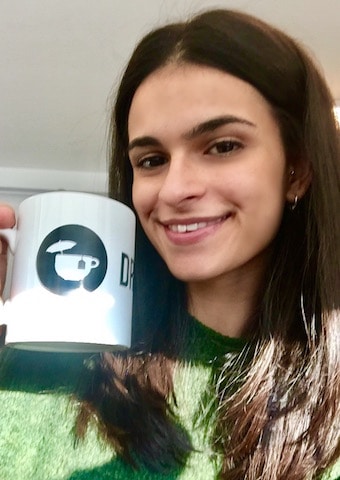 Five years on, this campaign is the biggest yet, says Nusha from Alcohol Concern (27 January)
Five years on, this campaign is the biggest yet, says Nusha from Alcohol Concern (27 January)
In 2012 we began what is now our flagship campaign at Alcohol Concern, Dry January. Since then, Dry January has gained momentum and a YouGov poll suggested that 1 in 6 of us attempted a Dry January in 2016.
The Dry January campaign is not about never drinking again; it is aimed at the social drinker, encouraging them to give up alcohol for a month and does not act as a medical detox programme! It is just a chance for people to reflect on their drinking patterns and to give their body a break after the festive period. It gives individuals an opportunity to break habits and feel the benefits from having a month off alcohol.
We’ve had some great feedback from participants over the years that suggested a month off of alcohol really can have a positive impact on your body. 79% of people reported saving money through the month, and 69% of participants detailed better sleep and more energy. In addition to this feedback, 49% also lost weight over the period. Research from the Royal Free Hospital in London has shown that there’s not only a positive effect on individuals’ appearance but also a positive effect psychologically.
Another thing that we’ve found is the ability of individuals to refuse a drink in a social situation improves. In our survey, between 60-70% of people who took part said they found it easier to refuse a drink. A great deal of feedback suggested that drinking had become a habit and that Dry January really allows individuals to re-evaluate their relationship with alcohol.
Research has also shown that Dry January is an effective behaviour change campaign. The most in-depth research yet, carried out earlier this year, showed that 67% of participants had sustained reduced levels of drinking six months after completing Dry January, 8% of whom stayed dry.
With 65,000 people signed up this year (and a community of over 46,000 on Facebook alone) we can be confident in holding the most successful Dry January yet, reaching and engaging with more people, offering them support and tips along the way.
 Dry January and Beyond
Dry January and Beyond
This year we launched our new Dry January & Beyond app, allowing users to input their weekly average drink intake and measure how much money and how many calories they were saving each day they continued to be dry. It has become a great source of motivation for better managing calorie consumption and counting the pounds in your pocket.
Last year, we piloted the Dry January app and with over 1,000 people continuing to use it after Dry January was over, our new app is designed up be useful and effective all year round! We’ve even created a Premium version for those who want some extra features, such as, customising the drinks and pricing more specifically and receiving more app articles.
New partnerships
This year, we have launched a new initiative with Virgin Money Giving where Dry January participants can choose to fundraise for us and a charity (or 3!) of their choice, splitting all the funds evenly. This unique partnership allows charities to work together on a campaign and see through shared goals. The partnership has been positively received and charities are promoting the Dry January campaign through their own networks. This will pave the way for an even bigger impact next year and illustrates how charities are able to work together.
How it has gone this year
This year we have 65,000 sign-ups with over 32,000 using the app globally – we’ve had great feedback about it from across the pond in the USA and down under in Australia! We had more than 300 workplaces promoting the campaign and encouraging their employees to sign up to Dry January, as well as creating online communities of their own to offer support to one another.
Bring on Dry January 2018!
ALCOHOL SNAPSHOT: UK and Ireland among the highest rates of drinking during pregnancy in the world
The UK is among the global ‘black spots’ for drinking during pregnancy and foetal alcohol syndrome, according to a recently published review of cross-country evidence. Dr Svetlana Popova and colleagues created a comprehensive global database recording the prevalence of each in every country.
As the chart above shows, practices vary dramatically between countries. Some of these differences are predictable, reflecting the relatively low levels of any sort of drinking in Africa and Asia. More striking, however, are the differences within the advanced economies – with, for example, the UK, Australia and Denmark having higher rates of drinking during pregnancy than the USA, Spain or Sweden. The Republic of Ireland has the highest rate in the world, with 60% of Irish mothers drinking. The UK ranks fourth, with alcohol consumption more prevalent only in Ireland, Belarus and Denmark.
These numbers are reflected in the prevalence of foetal alcohol syndrome, with Britain and the Republic of Ireland both suffering over 50 cases per 10,000, among the highest rates in the world.
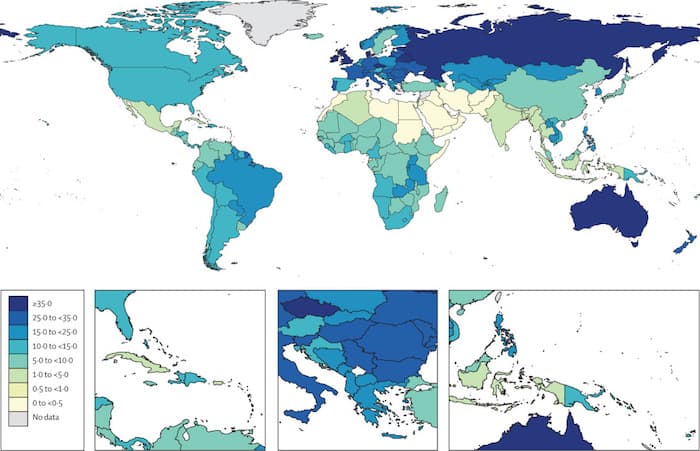
Podcast
Our monthly podcast features interviews with experts from across the sector.
BMA calls for reduction in drink driving limit
Professor Sir Ian Gilmore –
BMA and Alcohol Health Alliance
Suzanne Wood –
BMA

